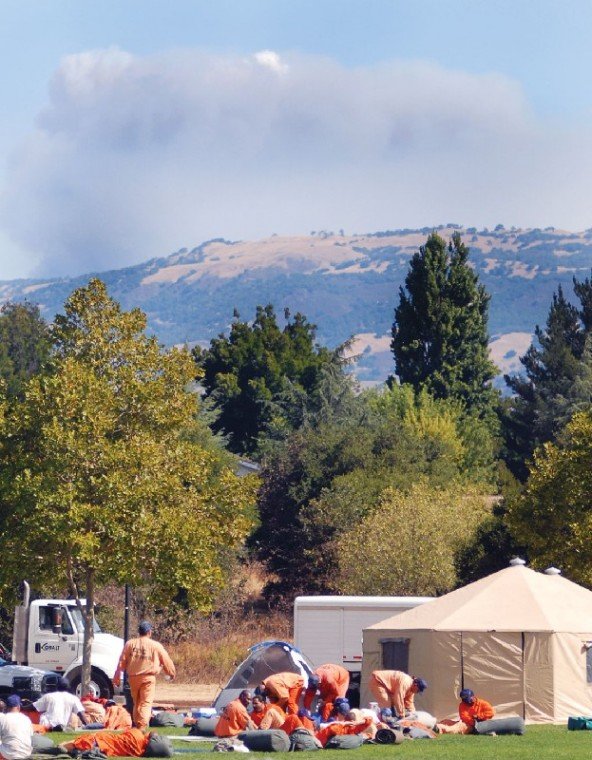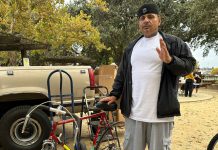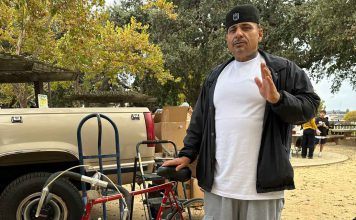Fire investigators have traced the mammoth fire consuming a
swath of Henry Coe State Park to an illegal burn barrel, lit on
private lands near Booze Lake in the park’s northeast section.
Gilroy – Fire investigators have traced the mammoth fire consuming a swath of Henry Coe State Park to an illegal burn barrel, lit on private lands near Booze Lake in the park’s northeast section.
That barrel has now set more than 11,000 acres ablaze, pulling firefighters from Sacramento to Orange County to the conflagration tearing through the park east of Morgan Hill. CalFire has enlisted 155 engines, 24 bulldozers, 34 fire crews, nine air tankers and eight helicopters – five of them from the National Guard – to battle the blaze, said CalFire spokeswoman Pam Rhoten.
Burn barrels are commonly used in rural areas to incinerate trash, but they’re illegal in the park area, said CalFire spokesman Dick Rawson.
“You take a large oil drum, shoot holes in it, and burn things inside it, so they don’t blow around – usually,” Rawson explained. “Maybe it did this time.”
As of press time Wednesday, CalFire staff knew of no arrests or citations connected to the fire.
Firefighters beat back 20 percent of the fire by Wednesday morning, and had held it north of Poverty Flat Road in the park. The fire is burning far from residential areas, has only destroyed one outbuilding, and is pushing toward the wilderness, not the cities. But the flames pushed into Stanislaus County to the east Wednesday morning, said Rawson.
“If those containment lines bust, we’re back to square one,” said CalFire Captain Kirk vanWormer, while waiting on an order of chicken cordon bleu, mashed potatoes, salad and steamed vegetables at Mimi’s Cafe in Gilroy. VanWormer had just finished a grueling 24-hour shift, outsmarting the flames on steep hillsides in the park, and opted to skip “camp food” before hitting the sack at a nearby motel.
Steep hillsides have delayed firefighters, who travel a single, cramped dirt road to reach the fire. Its farthest point is a three-hour trip along that path, deep within the park.
“Just getting out there is a bear,” said Napa fire captain Jim Pope. “The distance has been a real hindrance.”
Smoke choked the skies in Gilroy, Morgan Hill and Hollister Wednesday, and could have tipped air quality readings slightly higher in San Jose, where scientists measured 12 micrograms of particles per cubic meter, averaged over a 24-hour period. That falls far short of danger levels of 35 micrograms per cubic meter, said Karen Schkolnick, spokesperson for the Bay Area Air Quality Management District, but could be irritating to young children, asthmatics or the elderly. Current air quality readings for Gilroy were not available. At nearby Saint Louise Regional Hospital, few respiratory problems were reported, said spokeswoman Vivian Smith.
“Fires put out a lot of particulate matter,” said Schkolnick, “but we can’t say definitively what concentration of the particulate matter is attributable to the fire.”
Winds clocking 8 mph pushed smoke south into Gilroy and Hollister, but the heaviest effects were felt westward, in Watsonville and Santa Cruz, due to weather patterns, said National Weather Service forecaster Steve Anderson. The winds are expected to continue southerly through today, swinging to the east by Friday.
“It’s just been gray, gray, gray, and it’s all coming from that direction,” said Hollister resident Ruth Erickson, who called the Dispatch Wednesday to ask about the fire’s southernmost edge, worried by the smoke. “The blue sky disappeared and there are these clouds of pinky-dark smoke. All the cars around here have got this very fine dust on them. I won’t even get my car washed, until this is out.”
With multiple fires raging throughout the tinder-dry state, CalFire’s resources are strained, said Pope. Because the Lick Fire isn’t threatening homes, it’s a lower priority, despite its staggering size.
“People really need to be careful, even mowing a lawn or using a weed trimmer – it can take off, and it’s hard for us to play catch-up,” said Pope. “We still have the worst part of fire season ahead of us.”















